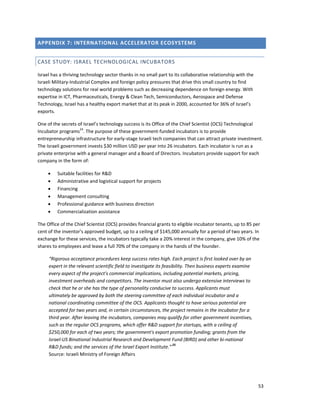This document discusses the need to strengthen British Columbia's entrepreneurship infrastructure and business acceleration ecosystem to support technology startups and commercialization. It outlines challenges such as the need for more high-growth companies, innovation, skills development, and global relevance. Two models are proposed: 1) a startup accelerator network with universities and non-profits, and 2) a standalone technology startup accelerator to carefully select and intensively support high-potential companies. The document argues this could help more startups succeed and establish BC as a major technology region.














































![Innovation & Commercialization: Rising to the Challenge through a Business Acceleration Ecosystem
B.C. Innovation Council Outlook 2020 Working Paper, Prepared for the BC Business Council, September 2009 Page 46
APPENDIX 5: SEED ACCELERATORS
Excerpt from: Jed Christiansen, A Framework for Seed Accelerator Programmes, University of Cambridge,
August 2009
YCombinator
Started summer 2005
http://www.ycombinator.com
Paul Graham, Robert Morris, Trevor Blackwell,
Jessica Livingston
Funding (previously): $5k + $5k*(number of
founders)
Funding (currently): $11k + $3k*(number of
founders)
Equity: between 2‐10%, average 6‐7%
Location: Mountain View, CA (2006‐present),
Boston, MA (2005‐2008)
Office space: No
TechStars
Started summer 2007
http://www.techstars.org
David Cohen, Brad Feld, David Brown, Jared
Polis
Funding: $6k*(number of founders), max $18k
Equity: 6%
Location: Boulder, CO (2007‐present) and
Boston, MA (2009‐present)
Office space: Yes
Seedcamp
Started fall 2007
http://www.seedcamp.com
Saul Klein, Reshma Sohoni
Funding: 50,000 Euros
Equity: 5‐10%
Location: London, UK
Office space: No
Summer@Highland
Started summer 2007 [??]
http://www.hcp.com/summer/
Michael Gaiss
Funding: $7.5k for an individual, $15k for a team
Equity: None
Location: Lexington, MA or Menlo Park, CA
Office space: Yes
DreamIT Ventures
Started summer 2008
http://www.dreamitventures.com/
David Bookspan, Michael Levinson, Steven D.
Welch , Steve Barsh, Katrina Hayday Wester
Funding: $5k‐$25k per person, depending on
role (Innovator, Strategist, Hacker). Each joins at
different time.
Equity: 4‐8%
Location: Philadelphia, PA
Office space: Yes
LaunchBox Digital
Started summer 2008
http://www.launchboxdigital.com
Sean Greene, John McKinley, Mark McDowell,
Julius Genachowski (Now FCC Chairman),
Matthew Jacobson
Funding: Up to $20k, option to invest pre‐
determined amount at end of program
Equity: 6%
Location: Washington, DC
Office space: No
SeedRocket
Started summer 2008
http://www.seedrocket.com
Vicente Arias, Jesús Monleón
Funding: 20k **Euros
Equity: [???]
Location: Barcelona, Spain
Office space: ??
AlphaLab
Started summer 2008
http://www.alphalab.org
Jim Jen
Funding: $25k
Equity: [???]
Location: Pittsburgh, PA
Office space: Yes](https://image.slidesharecdn.com/2145e295-1ee7-441f-bb85-75f81f9b9465-161014041027/85/2020_200909_BCIC-47-320.jpg)
![Innovation & Commercialization: Rising to the Challenge through a Business Acceleration Ecosystem
B.C. Innovation Council Outlook 2020 Working Paper, Prepared for the BC Business Council, September 2009 Page 47
BootupLabs
Started summer 2009
http://bootuplabs.com
Danny Robinson, Boris Mann
Funding: $50k plus $100k convertable line of
credit
Equity: 5‐10% post‐Series A
Location: Vancouver, Canada
Office space: Yes
fbFund
Started summer 2009
http://www.fbfund.com/
Dave McClure, Andrew Braccia, Enrique Allen,
Cat Lee, Julia Lam, Shaykat Chaudhuri
Funding: up to $100k
Equity: unknown
Location: Silicon Valley, CA
Office space: Yes
Shotput Ventures
Started summer 2009
http://www.shotputventures.com/
David Cummings, Sanjay Parekh, Allen Graber,
Suleman Ali, Wayt King, Dave Wright, Mitch
Free, Jeff Hilimire, Dave Williams
Funding: $5k + $5k*(number of founders)
Equity: 5‐10%
Location: Atlanta, GA
Office space: No
Capital Factory
Started summer 2009
http://www.capitalfactory.com
Joshua Baer, Sam Decker, Bryan Menell
Funding: as much as $20k
Equity: 5%
Location: Austin, TX
Office space: Yes
NextStart
Started summer 2009
http://www.nextstart.org/
[Unknown]
Funding: $5k*(number of founders), maximum
$10k
Equity: 5‐10%
Location: Greenville, SC
Office space: Yes
OpenFund
Starting fall/winter 2009
http://theopenfund.com/
Georgios Kasselakis, George Tziralis
Funding: 20‐30k **Euros
Equity: 8%
Location: Athens, Greece
Office space: Yes
Springboard
Starting fall/winter 2009
http://springboard.red‐gate.com/
Neil Davidson, Simon Galbraith, Amir Chaudhry
Funding: accomodation and living expenses (no
company funding)
Equity: None
Location: Cambridge, UK
Office space: Yes](https://image.slidesharecdn.com/2145e295-1ee7-441f-bb85-75f81f9b9465-161014041027/85/2020_200909_BCIC-48-320.jpg)












